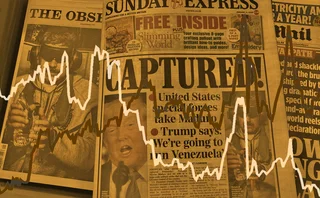
Reverse cliquets: end of the road?
Plunging equity volatility in the past six months may have hit dealers’ reverse cliquet and Napoleon hedge positions

Dealers quoting reverse cliquet and Napoleon option prices to European clients may have significantly underestimated the risks associated with such structures. And the reputedly low prices being offered by some dealers in the multi-billion-dollar Benelux market in particular have already forced a number of financial institutions to stop quoting on reverse cliquets and Napoleon option hedges.
Some dealers liken the present situation to that seen in the market in the second half of 2002. During that period, Goldman Sachs won practically every tender process it entered. Subsequently, the US investment bank, according to rival dealers, discovered it had botched its models and was forced to become a very active party in the volatility market in late 2002/early 2003 as it scrambled to hedge out its positions.
Problems pricing standard cliquet options are well documented (Risk July 2002, pages 22–24). These difficulties culminated in losses at a number of financial institutions, including French bank Natexis Banques Populaires, which reported a loss of €118 million related to structured equity products in 2002.
The decline in equity volatility in the past 12 months has significantly reduced the amount of leverage associated with reverse cliquet and Napoleon option products. As a consequence, this should have caused prices to flatten out. But the sharp fall in short-term volatility – from about 40% at the start of 2003 to a current level of 15% – may have hurt dealers that failed to fully factor in hedging costs in deals written in 2002 and early 2003.
Despite this, there is also evidence that a number of institutions still aggressively price reverse cliquet structures. NIBC Petercam Derivatives, part of the small Dutch investment bank NIBC, which has a stated objective to rapidly grow its structured equity derivatives products business, has drawn criticism from a number of rival dealers for being “too aggressive” in its reverse cliquet and Napoleon option pricing. NIBC Petercam’s head of trading Robert LeVine says the dealer has roughly €100 million of reverse cliquet and a similar figure of Napoleons on its books. He adds that the firm’s pricing has not changed and total positions are less than 5% of the firm’s total book value.
Equity derivatives stalwarts, such as BNP Paribas, Credit Suisse First Boston and SG, Société Générale’s investment banking unit, are all actively writing reverse cliquet and Napoleon option products, says Erwin Schoeters, a structured products managing director at KBC Asset Management – the largest issuer in the Benelux region, with structured product flow in excess of €1 billion a month. Schoeters says Dresdner Kleinwort Wasserstein is also very active in the market.
Alexis Rivard, Benelux head of equity derivatives at Crédit Agricole Indosuez Cheuvreux, says his bank simply cannot compete. “We are sure the risks in these structures are not being paid for,” says Rivard. “As an institution we will not take risks for which we are not being paid.”
Rudy Vermeersch, structured products executive at Benelux distributor of structured products Dexia Asset Management, says there are fewer dealers quoting prices in reverse cliquets than in the past. “I know there are some stories in the market that some people have problems with reverse cliquets,” he says. “What is true and not true is difficult to gauge.”
The head of equity derivatives sales at another large European bank says it is still quoting on a select number of reverse cliquet and Napoleon option products, but he adds that a number of dealers have stepped back from the market, including Crédit Agricole Indosuez Cheuvreux and Credit Lyonnais. He also cites BNP Paribas as less aggressive than it has been in the past, adding that NIBC Petercam’s pricing models appear to be different from those used by other dealers in the market. BNP Paribas’ head of exotic equity derivatives pricing in Paris, Herman Schoenmakers, says the French bank has continuously priced both instruments in large size. “It is true that sometimes we are less aggressive than the others. But if we don’t understand why the prices are much more aggressive, we will not try and match them,” says Schoenmakers. “We are happy with the deals we have made so far and we continue to quote them.”
Vermeersch says there can be many factors underlying apparent pricing discrepancies. For example, dealers might be offsetting other positions on their books. Equally, banks are often prepared to make a potential short-term loss to gain access to new clients to develop market share. Or dealers may become less aggressive or pull back from a market simply because they have hit their risk limits or management has imposed new restrictions on those risk limits.
But, quite frequently, vagaries in prices are the result of differences in quantitative models. And in extreme cases, this can cause dealers to quote prices that do not fully factor in the risks associated with selling particular structures.
Active dealers in reverse cliquet and Napoleon options that Risk spoke to denied suggestions they might not be factoring all the risks into their prices. “Most of the mis-pricing probably occurred at the end of 2002,” says Bernard Desforges, global head of sales and structuring in SG’s equity derivatives unit. “We noticed that in mid-2002 there was very significant mis-pricing from Goldman Sachs in particular, and we saw the firm trying to hedge heavily at the beginning of 2003.”
Other dealers also believed Goldman Sachs was heavily unwinding positions for what they termed “internal reasons”, at about this time. A Goldman Sachs spokeswoman said the firm became aware of pricing problems in the fourth quarter of 2002. She said Goldman Sachs discovered the problem earlier than many other banks and migrated swiftly to new, more sophisticated models. But Goldman Sachs declined to provide more specific details. Most of its rivals, however, believe the US investment bank faced difficulties accurately factoring in the costs of hedging the volatility of volatility in Napoleon option products. They say this was why Goldman was a heavy seller of cheap volatility early last year.
While sensitivity towards the volatility net change over the life of the equity option is often described as a ‘second-order’ parameter in classical options theory, effectively modelling the so-called vega convexity in reverse cliquets and Napoleon options is probably the most critical component in pricing.
And not all models deal with this volatility dynamic sufficiently and factor it into the cost of pre-hedging volatility moves. “A lot of banks that develop prices based on the Dupire model, for example, underestimate the future dynamic of the volatility and underestimate the price of the Napoleon,” says Richard Quessette, deputy head of structured products trading at SG. He adds that, unlike single barrier options where banks can deploy a static hedge of the vega risk using vanilla options, reverse cliquet and Napoleon option hedges cannot be static.
Credit Agricole Indosuez Cheuvreux’s Rivard agrees that stochastic volatility – or volatility of volatility – is a dominant parameter linked to winning deals: “Put simply, you buy volatility when it is getting more expensive and sell it when it’s getting cheaper – it’s a lose/lose transaction if it is not properly priced.” Rivard says these transaction costs need to be factored into the upfront price of reverse cliquets and Napoleons.
One option is to factor in how many times the volatility profile will shift significantly over the maturity of the hedge. But estimating this number is difficult. And the costs of getting it wrong are significant.
“For example, if you consider the volatility will go up and down x times in two years, rather than twice more often, the price of your option will drop by such a large extent that you are absolutely sure to win the deal,” says Rivard. “But if you get it wrong, you lose your shirt, as sensitivity to ‘volatility of volatility’ is extremely high.”
BNP Paribas’ Schoenmakers says the market as a whole has become increasingly short in stochastic volatility this year. “Volatility will move faster as all the banks are accumulating positions in the same direction,” he says. “The lower the vol gets, the more sensitive the market is to vega changes. The gamma on the volatility accelerates the vol moves and this can push the vol further down,” he adds.
KBC’s Schoeters says the raft of shorter maturity deals hitting the market at present makes it harder from a hedging perspective. For example, the KBC Click Europe Reverse Short structure on the Dow Jones Euro Stoxx 50 issued in October has a maturity of just 12 months – in the past it had typically issued products with a maturity of two to three years. The new one-year structures proved popular with investors keen to put money short term in equities without worrying about exit fees. Click pays 20% minus the monthly falls in the Eurostoxx 50 index.
“These structures are very sensitive to the volatility of volatility, especially when you go for really short maturities,” says Schoeters. “We had to make a lot of additional hedges during the substitution period. We didn’t have a full hedge for the €600 million from the start,” he adds.
But Schoeters says KBC received a number of prices for its hedges and the prices “were in line”. He adds: “I think most providers we deal with are really comfortable with the models they use and the prices they offer. There is not one counterparty standing out in a way we would consider it to be mis-pricing or that there is a flaw in the model they have used.” SG’s Deforges takes a similar view. “Things now look fine to us,” he says. “We are still trading very big deals at competitive prices.”
With volatility at such low levels, the evidence suggests that pricing vagaries would not be too noticeable. But should volatility increase rapidly – and most equity structurers believe a rise is overdue – the increased leverage available in reverse cliquet and Napoleon option structures would soon show who, if anyone, is prone to significant price discrepancies.
|
Only users who have a paid subscription or are part of a corporate subscription are able to print or copy content.
To access these options, along with all other subscription benefits, please contact info@risk.net or view our subscription options here: http://subscriptions.risk.net/subscribe
You are currently unable to print this content. Please contact info@risk.net to find out more.
You are currently unable to copy this content. Please contact info@risk.net to find out more.
Copyright Infopro Digital Limited. All rights reserved.
As outlined in our terms and conditions, https://www.infopro-digital.com/terms-and-conditions/subscriptions/ (point 2.4), printing is limited to a single copy.
If you would like to purchase additional rights please email info@risk.net
Copyright Infopro Digital Limited. All rights reserved.
You may share this content using our article tools. As outlined in our terms and conditions, https://www.infopro-digital.com/terms-and-conditions/subscriptions/ (clause 2.4), an Authorised User may only make one copy of the materials for their own personal use. You must also comply with the restrictions in clause 2.5.
If you would like to purchase additional rights please email info@risk.net
More on Markets
Brokers must shift HFT servers after China colocation ban
New exchange guidance drives rush for “proximity colo” in nearby data centres
LatAm FX carry trade shrugs off geopolitical fears
Clients in regional carry positions remain undeterred by US interventions, say dealers
S&P bull run drives interest in reset and lookback hedges
Variable strike put options proved popular alternative hedging format of 2025
US mutual funds slash short euro positions at record pace
Counterparty Radar: Pimco cut $4.6bn of EUR/USD puts in Q3 amid changing stance on dollar direction
Nomura hires new global eFX head
Mark McMillan to oversee e-trading and sales activities in newly created role
Trump’s LatAm gambit spurs FX hedging rush
Venezuela op boosts risk reversals as investors look to protect carry trades
One Trading brings 24/7 equity trading to Europe
Start-up exchange will launch perpetual futures Clob in Q1 after AFM nod
FXGO volumes surge despite fee switch-on
Dealers split on whether levy is behind volume increases across SDPs








